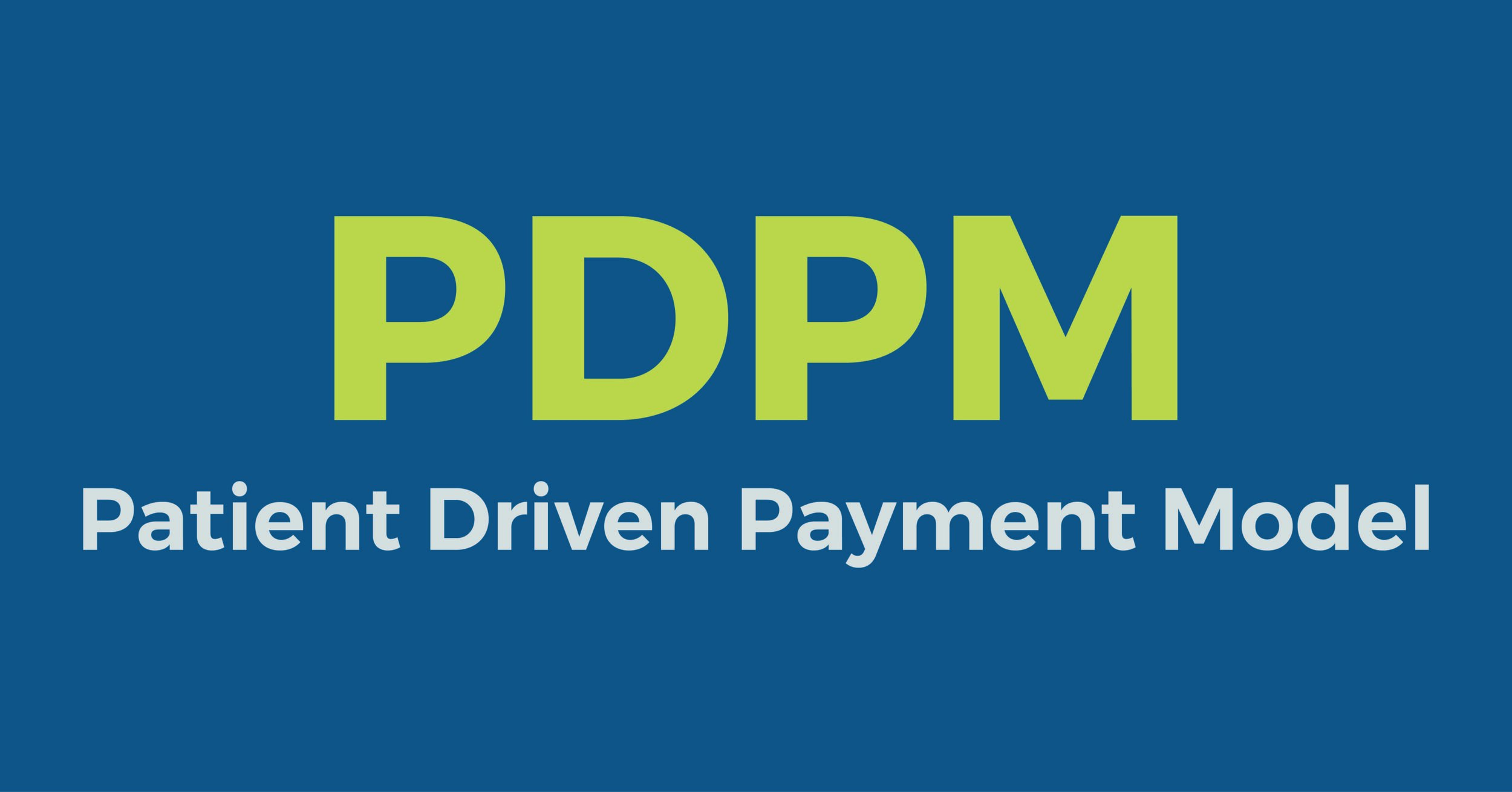PDPM Is Here – What You Need to Know
/The new Patient Driven Payment Model (PDPM) Medicare Part A reimbursement model takes effect October 1, 2019. PDPM will drastically change how reimbursement will be determined. Previously, the Resource Utilization Groups (RUG-IV) determined reimbursement, in which the amount of therapy a resident received played a significant part in the amount of reimbursement the facility received for that resident. As of October 1, reimbursement will transition away from the volume-based payments of RUG-IV toward the new PDPM model. With PDPM, ICD-10 codes will be a crucial driver for reimbursement.
It’s important to understand the significance of PDPM to your long-term post-acute care organization. Below are the top 10 things you need to know about PDPM:
PDPM uses clinical conditions to determine the resident’s therapy payment category rather than the amount of therapy provided. Payment will be based on the sum of the six components (five case mix adjusted components and a non-case mix component).
Physical therapy
Occupational therapy
Speech language pathology
Nursing
Non-therapy ancillary services
Non-case mix
Nursing categories continue to be determined by a resident’s conditions and services through a consolidated RUG IV classification system.
Physical and Occupational therapy case mix groupers will be determined by the following:
Clinical categories
Functional score now based on Section GG
Cognitive score
25% of Physical Therapy and Occupational Therapy minutes can be delivered by utilizing group and concurrent settings
Speech and language case mix grouper will be determined by the following:
Clinical categories
Swallowing disorder
SLP comorbidity or cognitive impairments
Presence of Mechanically Altered Diet and/or Swallowing Disorder
Non-therapy ancillary services (NTA) case mix grouper will be determined by a point-based case mix based on the following:
Comorbidity extensive services score
NTA tier
Age
There are approximately 50 items for which NTA Points are awarded and conditions/items earn more than 1 point
Nursing case mix grouper will be determined by the following:
Existing consolidated nursing resource utilization group (RUG) – will use 25 RUGS IV nursing categories
Functional measure based on Section GG
Classification End Splits based upon depression symptoms and restorative nursing services.
Non-therapy ancillary NTA services are used to adjust the case mix overall score; they consist of a score for a number of comorbidities coded on the MDS. There are 50 comorbidity conditions considered for the NTA score.
Multiple items were added to the MDS PPS discharge MDS assessment to capture the total amount of therapy provided during the Medicare stay. CMS has added more detailed requirements for reporting therapy minutes on the discharge MDS to track delivery of therapy.
The Medicare 5-day and Medicare PPS discharge MDS are the only MDS assessments required. The 5-day MDS will establish the PDPM payment category for the entire Medicare stay, unless an interim payment assessment is warranted due to a substantial change in the resident. An Interim Payment Assessment (IPA) may be used to capture significant changes in resident condition during the stay. An IPA would be completed if the change or changes are such that the resident would not be expected to return to his or her original clinical status within a 14-day period.
Budgeting for PDPM
Many of you are in the process (some WELL into the process!) of budgeting for the upcoming year. Many will be using projections either built by your staff from historical internal data or provided by outside consultants/software vendors to estimate the PDPM impact on the upcoming year. Doug Burr, Chairperson of the FHCA Reimbursement Committee, shared his thoughts on this process at the recent Reimbursement Committee Meeting and here are some valuable points to keep in mind.
First, make sure to fully understand and define the Medicare Days data and assumptions on which these projections are based because of the significant impact different assumptions will have on the Medicare A Revenue when trying to estimate PDPM rates.
There are two different approaches you can take to estimate your Medicare A revenues going forward under PDPM. Let’s use an example wherein we pull a sample period of Medicare Patient Days data (e.g., Q2-19 from 04/01/19 through 06/30/19) to project 2020 annual revenues. It is VERY important to define the sample of patient days to use for the timeframe selected and also consider the patient mix that your Medicare population consumes. The higher volume of Medicare residents will result in a less volatile fluctuation in estimated rates and “smooth” the waves of admissions and length of stay over the long run.
Approach #1 defines the sample days and also begins the PDPM rate calculation at the actual point each patient is at in their stay on the first day of the sample period (instead of PDPM Day 1). This will impact the variable component of Non-Therapy Ancillary Service (NTA) rate component, since not every patient included in the analysis would receive the high NTA rate for the first 3 days of the stay due to the assumptions in this methodology. This will also impact the therapies’ rates for PT and OT due to the Variable Adjustment Factor (VAF) phase down of the rate during the stay, though not as dramatically as the NTA impact. This approach is how PDPM would be reflected on financial statements from a GAAP accounting perspective (meaning that only what occurs in the selected sample period would impact the revenue calculation for that period). This approach will result in a lower average Medicare PDPM rate (although perhaps a more realistic rate) in that the average rate will assume your Medicare residents were admitted and discharged at variable times throughout the sample period.
Approach #2 would take the same sample time period (e.g., Q2-19; 04/01/19-06/30/19), but apply an assumption that the entire stay for each patient who had even 1 day of their stay within the sample period would be included in the Medicare Days data even if the stay began before or ended after the sample period used for computation of an average PDPM rate. This approach would include the NTA VAF of 3x for PDPM stay Days 1-3 for all patients and take into consideration the highest PT and OT rates.
Approach #1 would better reflect what you would expect to see as an average PDPM rate in financial statement for the time period selected (e.g., Q2-19; 04/01/19-06/30/19) based on the historical Medicare days data pulled, whereas Approach #2 would provide you with the actual average PDPM rate applicable to full stays for each patient who had at least one day of their stay within the selected period date range in the model you’re using to predict future PDPM rates and revenue. Approach #2 will almost always produce a higher average PDPM rate than Methodology 1 since that approach captures the Day 1-3 NTA and VAF for all Medicare residents and the highest PT/OT rate that declines over the length of stay. However, in reality, Approach #1 will reflect your Medicare resident population daily fluctuations and length of stay so the actual rate paid is applied to residents that entered your facility prior to the sample period. Approach #1 is the more conservative method whereas Approach #2 is more aggressive. Be careful not to over budget for revenues that in reality will not be consistently attainable.
Perhaps the more reliable method would be to budget using both approaches and take the average if you see a significant variance in your average rate between the two approaches discussed. Bear in mind that on October 1, the first day of PDPM, all Medicare residents will start out of the same gate and rates will include all the incentives and adjustments to the rate components. This will be important to remember when analyzing your revenue cycle going forward. That high tide for October through December revenues will flatten out starting next year as the normal cycle of admissions and discharges returns so it isn’t realistic to use Q4-19 as a good measuring stick of your future performance.
The moral of the story is to make sure you fully understand the assumptions being made by your staff or third-party consultants/software vendors when they are preparing PDPM rate estimates. Also, make sure the Budget Model used includes the Final Published Wage index information for FY 2020 and any facility specific adjustment that might apply such as the Value Based Purchasing (VBP) adjustment factor. (Note on the VBP factor – there was a release of updated VBP factors in late August due to an error CMS discovered in its calculation of the FY 2020 factors.)
Special thanks to Boris Kushnir of MSL CPAs & Advisors and FHCA Reimbursement Chair Doug Burr for assistance with this article.







